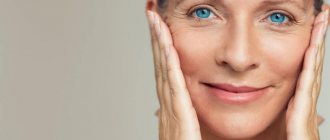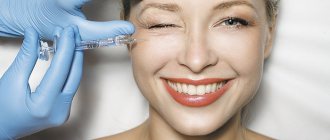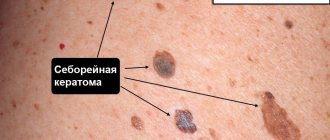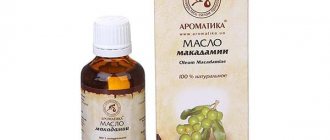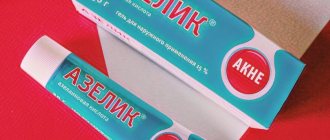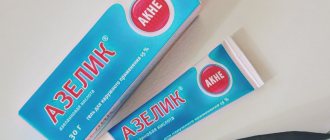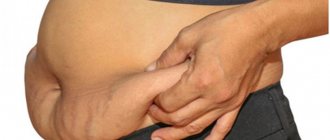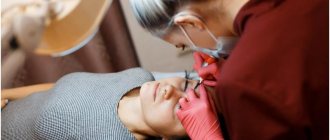The first signs of aging
As skin ages, the following changes occur:
- A decrease in the firmness and elasticity of the skin, the appearance of sagging, deepening of natural folds in the area of action of the facial muscles, the appearance of wrinkles;
- Change in skin color - the color may become less uniform, later pigment spots, dilated blood vessels, etc. may appear on the skin.
These changes occur as a result of gradual restructuring or disruption of the normal course of processes affecting the condition of the skin:
- Over time, the structure of collagen and elastin fibers in the skin is disrupted, and the additional production of these substances by cells decreases;
- The ability of the inner layers of skin to retain moisture deteriorates;
- Regeneration processes slow down;
- The layer of functionally active cells in the skin becomes thinner;
- The stratum corneum thickens.
All this leads to loss of moisture from the inner layers of the skin, a decrease in its elasticity, and the appearance and deepening of wrinkles. The skin becomes rougher and drier, and its shade may change.
Material and methods
The prospective study included 153 healthy people (129 (84.3%) women and 24 (15.7%) men) aged 26 to 78 years with varying degrees of involutional changes in the skin of the face and neck (mean age 47.1± 16.3 years; Me=44 years). Patients were divided into four age groups: 26-30 years (n=35; 22.9%); 31 years - 40 years (n=32; 20.9%), 41 years - 55 years (n=33; 21.6%), over 55 years (n=53; 34.6%). The main criterion for inclusion in the study was the absence of acute diseases, as well as chronic pathological conditions at the stage of subcompensation and decompensation. Informed consent was obtained in writing from each study participant.
The severity of involutional changes in the skin varied from 0 to III degrees (grade 0 - no wrinkles or single superficial wrinkles within the epidermis, corresponding to facial folds and elastic lines, appearing only with facial tension, the oval of the face is not changed, there is no sagging of soft tissues beyond the lower edge of the jaw I degree - superficial wrinkles are visualized within the epidermis, facial wrinkles partially disappear in the absence of facial expressions, a slight change in the oval of the face, sagging of soft tissues below the edge of the lower jaw up to 0.5 cm. II degree - single or multiple group wrinkles with skin folds, covering epidermis and dermis, facial wrinkles are not smoothed out with a calm facial expression, the presence of vertical skin folds in the parotid region, overhanging skin of the upper and lower eyelids, moderate deformation of the oval of the face, sagging of soft tissues below the edge of the lower jaw by 0.5-1.5 cm. III degree - deep single or multiple wrinkles, spreading over the entire skin in the form of chaotically located deep furrows, remaining permanently, the presence of vertical folds in the chin area, neck, doubling of skin folds of the lower eyelids, pronounced deformation of the oval of the face, sagging of soft tissues below the edge of the lower jaw more than 1.5 cm). Upon admission to the study, degree 0 of involutional changes in the skin of the face and neck was registered in 20.9% of those examined, degree I - in 24.2%, degree II - in 17.6%, degree III - in 37.3%. Naturally, with age, the severity of volitional changes increased.
To assess the state of free radical processes in the blood plasma, we examined the indicators of the generation of reactive oxygen species by leukocytes - the basal chemiluminescence intensity index (BICLb) and the zymosan-stimulated chemiluminescence intensity index (CICLc), the activity coefficient (AC) of the oxygen stage of SRP, calculated by the formula KA=PICLc/PICLb , and also studied lipid peroxide markers in terms of antiperoxide activity of secondary plasma (APA), which is the ratio of hydrogen peroxide-induced and spontaneous chemiluminescence of secondary plasma, and the indicator of malondialdehyde (MDA), a secondary product of lipid peroxidation that reacts with thiobarbituric acid.
To objectify the assessment of such parameters of the condition of the skin of the face and neck, modern instrumental research methods were used, the effectiveness of which has been repeatedly tested and valid [17]. To assess skin microcirculation, we used the laser Doppler flowmetry (LDF) method of facial skin (BLF-21 flowmeter, USA). To assess the state of skin metabolic processes, the state of tissue (intradermal) oxygen tension was studied using the non-invasive method of transcutaneous oximetry (TcpO2) using the TCM 400 Radiometer apparatus (Denmark). These studies were carried out at 10 points of the face (cheekbones, orbital, mandibular, frontal and chin areas).
Statistical data processing was carried out using SPSS 23.0 software using parametric and non-parametric criteria for assessing the statistical significance of differences. Differences were considered significant at p<0.05. Descriptive statistics of qualitative parameters are presented in the form of frequencies (abs, %), quantitative statistics - median (Me), lower (25%) and upper (75%) quartile. To compare two independent nonparametric samples, the Mann-Whitney test was used, and for multiple comparisons, the Kruskal-Wallis test was used. Correlations were calculated using the Pearson method.
Causes of skin aging
The onset of age-related changes occurs under the influence of various factors both within the body and from the external environment. The most common causes and factors include :
- Heredity - the speed and time of appearance of age-related changes is embedded in the genetic code of each organism, but the influence of other factors can slow down or intensify these processes;
- Hormonal changes - can be associated with natural changes in the body with age (menopause), or with various pathologies - diseases of the thyroid gland, gonads, etc.
- Lack of sleep;
- Bad habits and unhealthy lifestyle (diet errors, chronic dehydration - lack of moisture in the body);
- Wrong choice of cosmetics;
- Long and intense exposure to ultraviolet radiation.
To better understand how these factors affect the condition of the skin, you can take a closer look at the most common mechanisms of skin aging.
Error catastrophe theory
American scientist M. Szilard in 1954 put forward the theory of aging of the body due to an error. For a long time he studied the effects of radiation on living organisms. As a result of these studies, he found that radiation significantly shortens life expectancy. Under its influence, various mutations occur in DNA molecules, which, according to the scientist, are the main cause of aging.
However, the scientist did not describe the mechanisms of aging of people and animals that were not exposed to radiation. A follower of this theory, L. Orgel, believes that mutations in the genetic apparatus can occur both spontaneously and under the influence of various aggressive factors such as ultraviolet radiation, ionizing radiation, and exposure to viruses. In addition, over time, the DNA repair system wears out, which is why the aging process is activated.
Natural aging
The most important reason for the appearance of skin changes is a decrease in the production of collagen and elastin , which are necessary to maintain its healthy tone, elasticity and moisture.
Active care creams and serums help slow down the first changes during natural aging. However, for deeper wrinkles, routine home care and salon treatments are less effective. Thus, when the skin changes accumulated as a result of steady natural aging reach a certain “critical” point, the effect of cosmetic procedures becomes minimal and only plastic surgery can eliminate the signs of aging.
results
The study objectified the role of SRP in the development of involutive changes in the process of normal aging. This was especially true for indicators of the oxygen stage. PIHLs increased in proportion to age (from an average of 399.9 mV/s·106 leukocytes in young people under 30 years old to 856.2 mV/s·106 leukocytes in people over 55 years old; difference 2.14 times; p<0. 05); .05) (Table 1) .
Table 1. Oxygen indicators of free radical processes in healthy individuals of different ages
Note. Here and in the table. 2 : statistical results are presented as median (Me) and interquartile range (Q1:Q3). * — p<0.05 — significant difference between age groups. Comparison of three independent groups using the Kruskal-Wallis test; comparison of two groups - Mann-Whitney (1/2≤30 and 31-40 years, 1/3≤30 and 41-55 years; 1/4≤30 and >55 years; 2/331-40 and 41-55 years ; 2/431—40 and >55 years; 3/441—55 and >55 years).
As a result, with aging, CA increased on average from 4.3 in people under 30 years of age to 24.1 in people over 55 years of age (a difference of 5.60 times; p<0.05). Consequently, the KA indicator, demonstrating the intensification of reactive oxygen species, is a reflection of the involutional processes of the body associated with aging. It is important to note that no statistically significant differences in CRP levels were found between groups of patients aged 41 years - 55 years and over 55 years (p>0.05), despite the fact that the highest level of systemic ROS was found in the oldest age group (Fig. . 1) .
Rice.
1. KA indicator in different age groups. At the same time, the greatest differences were revealed when comparing the KA indicator of the youngest group with all other groups. This indicates fundamental physiological differences, expressed in the minimum quantities and level of intensification of ROS in the first period of maturity (up to 30 years), when energy metabolism is at a high level. Thus, in young patients aged 26-30 years, PIHLb was 1.48 times greater than in the group of 31 years - 40 years (p <0.05), 1.77 and 1.76 times greater than in those aged 41 years - 55 years and over 55 years, respectively (p <0.05). Compared with the youngest group, PIHLs in the group of 31 years - 40 years was 1.28 times more (p <0.05), 41 years - 55 years - 1.90 times more (p <0.05), in in the group over 55 years old - 2.14 times more (p<0.05). KA in people aged 31 years - 40 years, 41 years - 55 years and over 55 years was 2.65 times, 4.30 times and 5.60 times, respectively, greater than in people aged 26-30 years (p <0.05).
Lipid peroxide indicators of PRP (MDA and APA) in somatically healthy people of different ages on average remained at a statistically indistinguishable stable level, while there was a clear tendency towards an increase in lipid peroxidation products with aging, which was expressed in a systematic increase in the MDA indicator from 2. 6 µmol/l in women under 30 years of age to 2.9 µmol/l in persons over 55 years of age (Table 2) .
Table 2. Oxygen indicators of free radical processes
Thus, the most significant differences were recorded between the groups of subjects under the age of 30 and over 55 years. At the same time, no significant differences in PSA indicators were found in the age groups 41 years - 55 and over 55 years.
These changes can easily be explained by the presence of compensatory tissue hypoxia and decreased tissue blood flow in the older age group, which was also shown by instrumental methods for assessing their condition. This was expressed in the relatively early formation of disturbances in metabolic interstitial processes due to changes in the structure of the microcapillary bloodstream.
According to laser Doppler flowmetry (LDF), it was found that facial skin microcirculation indicators decreased significantly with age. Thus, the average total LDF indicators (including the general quantitative representation of blood flow at all measured points) in persons under 30 years of age averaged 8.1 ml/min (interquartile range [6.3; 9.5] ml/min), and in people over 55 years old - 6.4 ml/min (interquartile range [5.2, 7.7] ml/min), the difference is significant (p <0.05). However, when comparing borderline groups, reliability was not obtained, i.e. the blood flow of the microcirculatory bed in people aged 41 years - 55 years and over 55 years was comparable, the LDF indicators in people aged 31 years - 40 years and 41 years - 55 years were also indistinguishable, while a significant difference of 1.2 times the average total LDF indicator between age groups 31 years - 40 years and over 55 years (p<0.05).
Thus, the LDF results characterize a decrease in microcirculation parameters with age. These results are consistent with data from a study of microcirculation parameters at TcpO2, which characterize the age-related involution of tissue oxygenation. The difference in TcpO2 in people under 30 years of age (Me = 56 mm Hg, interquartile range [49; 62] mm Hg) and in people over 55 years of age (Me = 35 mm Hg, interquartile range [ 30; 39] mmHg) averaged 1.6 times (p<0.05) (Fig. 2) .
Rice.
2. Indicators of tissue oximetry and microcirculation of facial skin in healthy people of different ages. A direct correlation has been established between age and the levels of tissue (intradermal) microcirculation of facial tissues (r=0.381; p<0.05). In addition, an inverse correlation was established between LDF and such indicators of oxidative stress as KA (r=–0.419; p<0.05) and PIHLs (r=–0.390; p<0.05), as well as a direct correlation with PIHLb (r=0.324; p<0.05).
Consequently, with age, tissue metabolism and microcirculation indicators naturally regress, which is associated with an increase in reactive oxygen species, the excess of which leads to the intensification of peroxide processes. This in turn is reflected in the aesthetic appearance, manifested by aging.
Photoaging
When the sun's ultraviolet rays (or UV rays from a tanning bed) are regularly exposed to unprotected skin, gradual damage occurs. Moreover, all changes in skin cells and their genetic material that occur under the influence of UV exposure tend to accumulate. This means that the consequences of excessive tanning in youth can affect the skin later. This type of skin damage is clinically known as photoaging and can lead to age spots, facial spider veins, fine lines and wrinkles, and in some cases even skin cancer.
To protect your skin from photoaging, be sure to use creams with ultraviolet protection before going outside.
Introduction
Improvements in the quality of life and advances in healthcare are accompanied by an increase in life expectancy and the aging of the planet's population, which is today a relevant and widely discussed political, social and medical topic [1–3].
Studying the processes of normal aging is especially important; this will allow the elderly of the future to have active longevity not only physically, but also aesthetically [4]. In this regard, the study of the physiology and pathophysiology of aging, the early signs of which appear externally on the skin of the face and neck, is the basis for effective methods of combating involutional manifestations and prolonging youth. Currently, the free radical theory of aging is generally accepted [5–7]. Mitochondria generate reactive oxygen species (ROS) in the form of superoxides and other forms as by-products of inefficient electron transfer along the electron transport chain [8–10]. Superoxide radicals can further react to form other ROS, such as hydrogen peroxides and hydroxyl radicals. These superoxides and other ROS can damage mitochondria and further reduce the efficiency of the mitochondrial transport network, leading to positive feedback and increased mitochondrial oxidative damage. However, despite the fact that numerous studies have shown the detrimental role of ROS and oxidative stress on the mechanisms of aging, other authors suggest that the generation of ROS is not always the cause of cellular aging [10–16].
The purpose of this study is to study the role of free radical oxygen and lipid peroxide processes along with studying the level of blood flow and oxygen saturation of facial tissues in patients of different ages with varying degrees of involutional changes in the skin of the face and neck.
The influence of bad habits
Smoking, alcohol and drugs cause biochemical changes in the skin, increasing the amount of free radicals, which can accelerate the aging process.
Studies have shown that the skin of a person who smokes half a pack a day for 10 years is much more likely to develop deep wrinkles than the skin of a non-smoker. In addition, smokers' skin may acquire a yellowish tint, and chemicals that enter the body during smoking or inhaling cigarette smoke can destroy the structure of the skin's elastin fibers.
Alcohol abuse leads to accelerated loss of moisture from the skin, the appearance of areas of dryness, irritation, and small dilated blood vessels, especially in the facial area. Alcohol and drugs cause damage to the liver, which can lead to yellowing of the skin.
Telomere theory
This theory emerged based on the research of the American scientist L. Hayflick, who proved that skin cells (fibroblasts) are capable of dividing. Namely, in a test tube they can divide up to 50 times. However, the researcher did not explain this process in any way. A.M. gave his explanation for this phenomenon in 1971. Olovnikov. His hypothesis was based on the fact that each time a cell divides, a chromosome shortens.
The fact is that chromosomes have specific end sections (telomeres), which become shorter after doubling. At the same time, sooner or later they shorten so much that the cell stops dividing. Because of this, cells lose their viability. The hypothesis about the shortening of chromosomes and the death of cells due to this formed the basis of the molecular genetic theory of aging.
Scientists were able to confirm this theory in 1985 after the discovery of the enzyme telomerase, which is capable of completing shortened telomeres in tumor and germ cells, thereby ensuring their immortality. However, not all cells have a limit of 50 divisions. For example, stem and cancer cells can divide almost endlessly.
Prevention of skin aging
The following can help slow down age-related changes:
- Proper nutrition and daily consumption of clean drinking water, as well as reducing the amount of caffeine (which accelerates moisture loss from the skin);
- Refusal of harmful addictions (exclude smoking, do not abuse alcohol, etc.);
- Healthy sleep pattern;
- Use of creams and cosmetics with sunscreen components.
Compliance with these rules will be useful not only for the prevention of aging, but also for those who have gotten rid of the signs of skin aging through plastic surgery and want to maintain the excellent results of this procedure for as long as possible.

